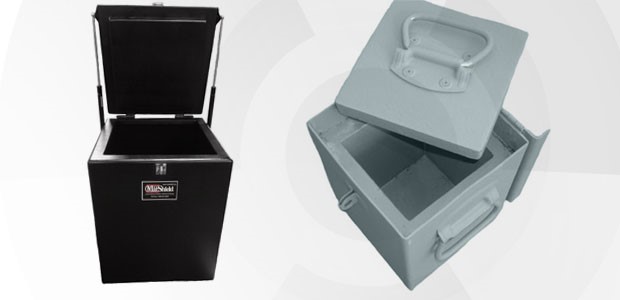Gamma Ray Attenuation Properties of Common Shielding Materials
Share:
Mars Metal Company/MarShield, Burlington, ON
Posted on Nov 9, 2022
MarsMetal Company is a North American manufacturer and global leader in lead casting, lead fabrication, and radiation shielding products for the construction, medical, & nuclear industries.
Shielding for Radiation comes in many available products and design characteristics; some being more effective than others. Radiation Shielding and Protection is a very serious subject. What follows is just a basic overview of what’s available along with the variation of protection.

Attenuation or shielding of gamma radiation is an important component of radiation safety programs aiming to reduce personnel exposure to ionizing radiation. Attenuation data for commonly used shielding materials is available in many resources, such as the National Institute of Standards (NIST) XCOM database of attenuation. Ultimately, selecting the most appropriate shielding material for a given source of ionizing radiation will require knowledge of the source of radiation, application of attenuation data from available resources, and an understanding of the basic principles gamma ray interactions with matter. Also; other factors, such as cost and chemical compatibility must be considered. MarShield understands each shielding situation is unique and should be custom tailored to the specific project and application.
Definition of common terms:
Gamma ray. High-energy electromagnetic radiation is typically emitted from the atomic nucleus during nuclear decay processes.
X-ray. Fundamentally the same as gamma rays; but originating from electrons outside the atomic nucleus. Some resources may also distinguish gamma rays and x-rays based on energy.
Photon. An elementary particle of electromagnetic radiation.
Intensity or Flux. The number of photons detected or emitted over a time period.
Electron volt (eV). Unit of energy of gamma or x-ray photons, equal to 1.60 x 10-1? joules. More often expressed as 1,000 eV = keV or 1,000,000 eV = MeV.
Photopeak. Peak observed in gamma ray spectrometry resulting from the deposition of the entire energy of the gamma photon within the detector. The energy or energies of the gamma ray photopeak(s) for a particular radionuclide can be used to identify the radionuclide. For example, Co-60 emits gamma ray photons with photopeaks at 1173 and 1333 keV.³
Primary Radiation. Similar to photopeak. Source radiation or radiation passes through the shielding material without its energy diminished through any scattering interactions.
Secondary Radiation. Also referred to as scattered radiation. Radiation which passes through the shielding material at diminished energy after undergoing scattering interaction(s) or is produced as a by-product of scattering or absorption of radiation.
Photoelectric effect. The complete transfer of energy from a gamma ray photon to an atomic electron of the shielding material. Photoelectric absorption is more common for lower energy gamma radiation (
Compton scattering. The transfer of part of the energy of a gamma ray photon to an atomic electron of the shielding material. After undergoing Compton scattering, the gamma photon may undergo further scattering or absorption interactions with the shielding material and/or emerge from the shielding material with diminished energy. Compton scattering is predominant at relatively high gamma energies (500-1500 keV) and for shielding constructed from low atomic weight materials (H?O, Al, Fe).
Pair production. An interaction of a gamma ray photon with the nucleus of an atom results in the creation of beta particle and a positron. The positron then undergoes an annihilation reaction with an electron to produce two 511 keV gamma rays. The incident gamma radiation must have a minimum energy of 1022 keV to undergo pair production. Pair production becomes an important attenuation interaction for very high energy radiation (>1500 keV).
Attenuation coefficient. A quantity that characterizes how easily electromagnetic radiation penetrates a material. The attenuation coefficient is often expressed in terms of unit area per mass (cm²/g). The attenuation coefficient and the material density can be used to estimate the transmission of gamma radiation through a chosen thickness of shielding material, or the thickness of a shielding material required to achieve a desired level of attenuation. Gamma attenuation coefficients are inversely dependent on gamma energy and directly proportional to the atomic number of the element(s) from which the shielding material is constructed.
Buildup Factor. A correction factor is used to account for the increase of observed radiation transmission through shielding material due to scattered radiation. Buildup factors are dependent on the energy of the primary radiation, the composition of the shielding material, and the thickness of the shielding material. Tables of buildup factors for many materials are available. 4,5
Half Value Layer (HVL). The thickness of material required to reduce the intensity of radiation to one-half of its original intensity (50% attenuation).
Tenth Value Layer (TVL). The thickness of material required to reduce the intensity of radiation to one-tenth of its original intensity (90% attenuation).
MarShield Shielding Materials & Solutions
MarShield is North America’s premier lead caster, manufacturer, and global supplier of gamma and neutron radiation shielding products. We understand the unique challenges faced in various industries and are proud to provide specific shielding solutions that meet our customer’s needs.
We have extensive lead casting capabilities with the ability to create custom or standard products to meet your requirements. Our lead-lined cabinets for Nuclear Medicine or Radiochemistry laboratories are a customizable solution with standard options also available. Other MarShield nuclear medicine solutions include tungsten vial and syringe shields, lead and tungsten storage containers, lead curtains, and brick caves/L-Block shields. Visit our website to find additional product solutions. If you cannot find the solution you are looking for, contact us for more information.
Source Destination: https://marshield.com/gamma-ray-attenuation-properties-of-common-shielding-materials/


